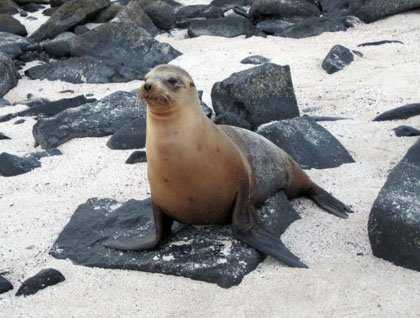Our complete first day in the Galapagos was spent at Española, otherwise known as Hood Island, which is considered the oldest island in the archipelago. This island features great endemism and offers a real explosion of life with incredible creatures everywhere. With excellent weather conditions, a radiant sunny day and turquoise waters, our intrepid snorkelers decided to explore the deeper waters along the coast of Gardner Islet that faces Española Island. We observed schools of surgeonfish, black-stripped salemas and colorful invertebrates along the vertical walls of the cliffs, which dip to a depth of more than 100 feet. Playful juvenile Galápagos sea lion decided that we looked interesting and came to check us out, showing us its agility, swimming in circles and blowing bubbles at the strangely dressed humans.
After snorkeling, the coralline sand beach welcomed us all and we had a great chance to interact with many sea lions resting on the beach. Newborn pups moved up and down the beach searching for their mothers as hunger pings in their stomachs. Females promptly and vocally deny any access to pups that are not their own, while large bull sea lions patrol their territories. Española mockingbirds flitted about the beach, digging in the sand for sustenance as they constantly bleeped out various intonations. As we lest the beach and headed back to our floating home, brown pelicans and frigatebirds glided overhead.
After lunch and a short navigation to the western area of Española, we arrived to Punta Suarez. There is not a great deal of biodiversity in the archipelago, however, fascinating mixes of unique species have developed in this isolated environment. As we ventured along the path, we had to step over marine iguanas that were warming their tepid bodies after a foray into the cool waters to feed upon algae. Nazca boobies awakened our senses with their high-pitched screech, while flying overhead searching for nesting areas along the cliffs. During this “dry” season, matted dry grass and skeletal croton bushes surround the boulders on the path. Mockingbirds followed us looking for any opportunities, to consume some food or water. As we arrived at the cliffs, we had the first encounter with the biggest sea bird of the archipelago—the waved albatross. We saw a few chicks and juveniles, one abandoned egg and many adult albatrosses displaying their elegant and unique courtship dance, which consists of a combination of beak “jousting,” neck swaying, sky pointing, and deep calls. These majestic birds soared by as they searched for their chicks among the colony, eventually landing haphazardly on the cliff. With the last beams of sun, we headed back to the National Geographic Endeavour, observing the beautiful sunset illuminating this incredible place, with innocent creatures that we hope will remain with us forever.







